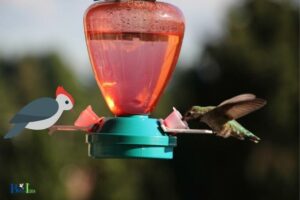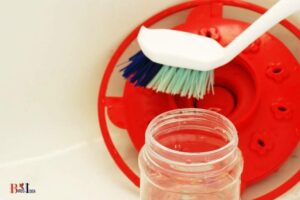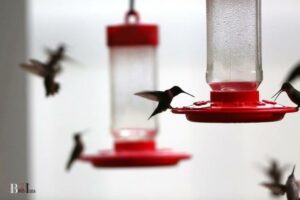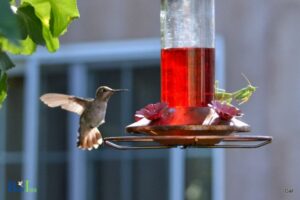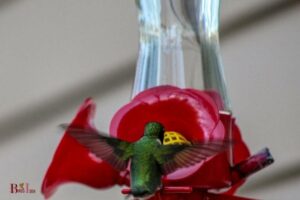Why is My Hummingbird Feeder Not Working: Improper!
A hummingbird feeder may not be working due to improper positioning, unattractive or spoiled nectar, leakage, or competition from other birds and insects.
Hummingbird feeders are designed to attract and provide food for hummingbirds. However, there are several reasons why a feeder may not be functioning effectively.
These can include the location of the feeder, the quality of the nectar, issues with the feeder itself, or competition from other creatures that may deter hummingbirds from visiting.
If your feeder is leaking, it may not only deter hummingbirds but also attract ants and other insects. Make sure the feeder is in good condition and clean it regularly to prevent any issues.
Lastly, hummingbirds may avoid your feeder if there is intense competition from other birds or insects, so consider placing multiple feeders at different locations to reduce competition and make it more accessible to hummingbirds.
9 Common Problems and Solutions for Hummingbird Feeders
| Problem | Possible Cause | Solution |
| No hummingbirds coming to feeder | Location | Place the feeder in a visible area, preferably near flowers, and away from direct sun, wind, and predators. |
| Feeder cleanliness | Ensure the feeder is clean and free of mold, as this can deter hummingbirds from visiting. | |
| Nectar | Check the nectar concentration (4 parts water to 1 part sugar) and change it every 2-3 days to keep it fresh. | |
| Leakage or dripping | Damaged feeder | Check for cracks, broken parts, or damaged seals, and replace if necessary. |
| Overfilled feeder | Leave some space at the top of the feeder to avoid dripping. | |
| Temperature changes | Keep the feeder in a shaded area to prevent expansion and contraction of nectar due to temperature changes. | |
| Ants or bees invading | Attraction to nectar | Use an ant moat or bee guards on the feeder to deter ants and bees from reaching the nectar. |
| Mold growth | Infrequent cleaning | Clean your feeder thoroughly with hot water and a mild detergent at least once a week, and rinse well before refilling. |
| Color fading | Sun exposure | Consider using a feeder with UV protection or relocate the feeder to a shadier area. |
Key Takeaway
Five Facts About: Hummingbird Feeders Not Working
Insights: Why Is My Hummingbird Feeder Not Working?
Hummingbirds are fascinating creatures that bring joy to many gardeners across the globe. However, sometimes when we set up hummingbird feeders, these magnificent little birds don’t use them.
We will delve into the insights about why your hummingbird feeder might not be working as it should be.
Common Issues With Hummingbird Feeders
Hummingbird feeders are simple in construction and function, but various problems can arise, making it less effective.
Some of the common issues with hummingbird feeders are:
- Dirty feeder: Hummingbirds are quite discerning when it comes to feeding, and they are not attracted to dirty feeders. Make sure you clean your feeder regularly with hot, soapy water, at least once a week, and rinse it thoroughly with fresh water.
- Leaking feeder: Check for any visible cracks or holes, which can cause a leak in the feeder. Even a small leak can cause a drop in the nectar level, and hummingbirds may avoid visiting your feeder. Check the feeder’s rubber gaskets, washers, and fasteners to ensure that everything is secure and tight.
- Unattractive nectar: Hummingbirds are attracted to bright colors, including reds and oranges. Therefore, it’s best to choose a feeder with bright colors to attract the birds. Additionally, ensure that you use fresh nectar as it can spoil quickly, and hummingbirds will not drink stale nectar.
Importance Of Identifying The Cause
Identifying the problem with your hummingbird feeder is essential to attract hummingbirds to your garden.
Here are some reasons why identifying the cause is necessary:
- Saves time and money: A malfunctioning hummingbird feeder can consume time and money. By recognizing the problem, you can take corrective action and avoid unnecessary expenses.
- Attracts hummingbirds: Once you identify the cause, proper corrective measures can be taken, making the feeder work correctly, thus attracting hummingbirds.
- Promotes bird’s health: When you maintain and clean the feeder appropriately, you prevent the spread of harmful bacteria and fungus that can harm the birds, promoting their safety and health.
Taking care of hummingbird feeders is vital for the birds’ well-being and enjoyment in your backyard. By recognizing the issues, you can fix them timely, making the feeder work efficiently, and attract these tiny feathered friends to your garden.
Inspect Your Feeder: Identifying Problems
If you’re having trouble attracting hummingbirds to your feeder, don’t worry. There are several reasons why it may not be working correctly.
One of the main issues can be with the feeder itself. In this section, we’ll take a closer look at how to inspect your feeder to identify any problems.
How To Check For Leaks And Cracks
One of the most common problems with hummingbird feeders is leaks and cracks. These issues can go unnoticed, but they can be problematic for attracting birds.
Here are some tips for inspecting your feeder for leaks and cracks:
- Check for cracks or holes in the plastic or glass of the feeder.
- Look for any missing or broken components, such as the feeding ports or perches.
- Fill the feeder with water instead of nectar and observe it for leaks.
If you identify any of these issues, you may need to repair or replace your feeder.
Cleanliness And Hygiene Concerns
Another critical factor to consider is the cleanliness and hygiene of your feeder. Hummingbirds are attracted to fresh nectar, and if your feeder is dirty, it can deter them from visiting.
Here are some steps to take to keep your feeder clean:
- Wash the feeder with hot water and soap regularly.
- Replace the nectar every few days, especially in warm weather.
- Use a bottle brush to clean hard-to-reach areas of the feeder.
Remember to wear gloves and protective gear when handling your feeder and nectar. Proper cleaning and hygiene will ensure a steady stream of hummingbirds.
Susceptibility To Ants And Wasps
Ants and wasps can be a significant problem for hummingbird feeders. They can contaminate the nectar and discourage hummingbirds from visiting.
Here’s what you can do to address this issue:
- Use an ant moat to keep ants away from the nectar.
- Hang the feeder higher off the ground to dissuade wasps.
- Use wasp traps to catch any lingering insects.
By taking these measures, you can decrease the appeal of your feeder to ants and wasps and encourage hummingbirds to visit.
Be sure to conduct regular maintenance and inspections of your hummingbird feeder. With proper care and attention, you’ll attract these striking birds and enjoy watching them feed.
Troubleshooting: Simple Fixes For Common Issues
Hummingbirds are fascinating creatures, and providing them with a reliable food source adds to the interest and excitement they bring to our surroundings.
However, even with a good-quality feeder, issues may arise that lead to your hummingbird feeder not working correctly.
In this section, we will explore some of the common issues that can occur with hummingbird feeders, along with some simple fixes to troubleshoot them.
Examining The Nectar Solution
The most critical aspect of maintaining a hummingbird feeder is the nectar solution. A stale nectar solution or an incorrect mix ratio can lead to a decline in hummingbird visits.
Here are some key points to consider when examining your nectar solution:
- Ensure that the ratio of sugar and water is correct. The proportion should be 1: 4 for sugar and water, respectively.
- Use only high-quality white granulated sugar to make the nectar solution.
- Always prepare the nectar solution with hot water to help mix the sugar completely.
- Change the nectar solution every two to three days, especially during hot weather, to prevent fermentation and mold growth.
Adjusting The Feeder Location
Another way to troubleshoot feeder-related issues is to modify its location. A poorly positioned feeder can be uncomfortable for hummingbirds, thereby reducing their visits.
Here’s what to keep in mind when adjusting the feeder location:
- Hang or mount the feeder where it is visible for hummingbirds and in a shaded area to prevent the nectar solution from overheating in the sun.
- Ensure that the feeder is near the natural food source for hummingbirds, such as flowers and insects, to attract them.
- Place the feeder away from other bird feeders; this minimizes the competition for hummingbirds.
- Position the feeder away from busy areas and windows to lessen the risk of birds colliding with window panes.
Using Protective Covers
The use of protective covers is also an effective way to resolve hummingbird feeder issues. Protective covers can help extend the life of your feeder and protect it from elements that can minimize hummingbird visits.
Here are some key points to consider when using protective covers:
- Protect the feeder from direct sunlight, especially during the hot summer months.
- Use a protective cover to keep ants and other insects at bay and prevent the nectar solution from contamination
- Add a rain guard to prevent the nectar solution from being diluted in rainy weather.
- Shield the feeder from strong winds, which can lower the quality of the nectar solution and discourage hummingbirds.
By examining the nectar solution, adjusting the feeder location, and using protective covers, you can troubleshoot many common issues that may interfere with your hummingbird feeder’s performance.
These simple fixes can help you ensure that your feeder is in good working condition and attracting a range of hummingbirds.
Dealing With Persistent Issues: Advanced Solutions
Hummingbird feeders are a fantastic way to attract these beautiful, tiny birds to your garden. Unfortunately, despite your best efforts, your hummingbird feeder may stop working or underperform.
You’ve cleaned it, refilled it with fresh nectar, and checked all the components, but the problem persists.
Don’t worry; we’ve got you covered. In this section, we’ll explore some advanced solutions to deal with persistent hummer feeder issues.
Cleaning The Feeder Components
Cleaning is the first step to troubleshoot a problematic feeder. However, if you’ve already tried this, it’s time to take a closer look at the individual components.
Here are some key points to consider:
- Remove the feeder’s perches, ports, and base to dry and clean them.
- For tough stains or mineral deposits, soak the components in a solution of warm water and white vinegar. Rinse well to avoid any lingering vinegar odor.
- Check for mold or bacteria inside the feeder. If present, discard the nectar and clean the feeder with a mild bleach solution (one-part bleach to nine parts water). Rinse well and let it dry before refilling.
Replacing Worn-Out Parts
Hummingbird feeders can wear out over time, especially if you live in an area with harsh weather.
Here are some things to look for when considering replacement of certain elements:
- If the feeder has scratches, cracks, or chips, it may be time to replace it.
- The perches and ports are essential components of hummingbird feeders, but they can get damaged if mishandled or chewed on by squirrels. Consider purchasing replacement ports or perches if they’re beyond repair.
- The nectar reservoir is another critical component, but they can become brittle with time or due to exposure to the sun’s uv rays. If it’s cracked, replace it.
Consulting A Professional
If your feeder’s persistent problems are still not resolved after cleaning or replacing its components, it’s time to consult a professional.
Here are some quick tips for getting expert advice:
- Ask your local bird store for recommendations on reliable hummingbird feeder experts.
- Some hobbyist hummingbird organizations provide free consultation services as well.
- If the feeder is within warranty, check with the manufacturer for possible repair or replacement options.
Now that you know how to deal with persistent issues with hummingbird feeders let’s hope your tiny flying friends will return to your garden. With a little maintenance and care, you can keep your feeder humming smoothly for years to come.
Happy birding!
FAQ For Why Is My Hummingbird Feeder Not Working
Why Are Hummingbirds Not Coming To My Feeder?
How Often Should I Replace The Nectar In My Feeder?
What Is The Best Location For My Hummingbird Feeder?
What Is The Ideal Nectar Recipe For My Feeder?
Conclusion
A hummingbird feeder can bring so much joy to your backyard, but it can be frustrating when it’s not working correctly. After reading this article, you should have a good understanding of the most common reasons your feeder may not be working.
First, check your feeder for any leaks, and make sure it’s clean and dry before adding fresh nectar. Consider trying a different type of nectar or feeder if the birds aren’t interested. Make sure your feeder is in a safe location away from predators and in a spot that’s easy for the birds to find.
Overall, patience is key when it comes to attracting hummingbirds to your feeder; it may take some time for them to discover it. With a bit of troubleshooting, you can figure out why your hummingbird feeder is not working and with these tips, you’ll be on your way to attracting these beautiful birds to your backyard in no time.

